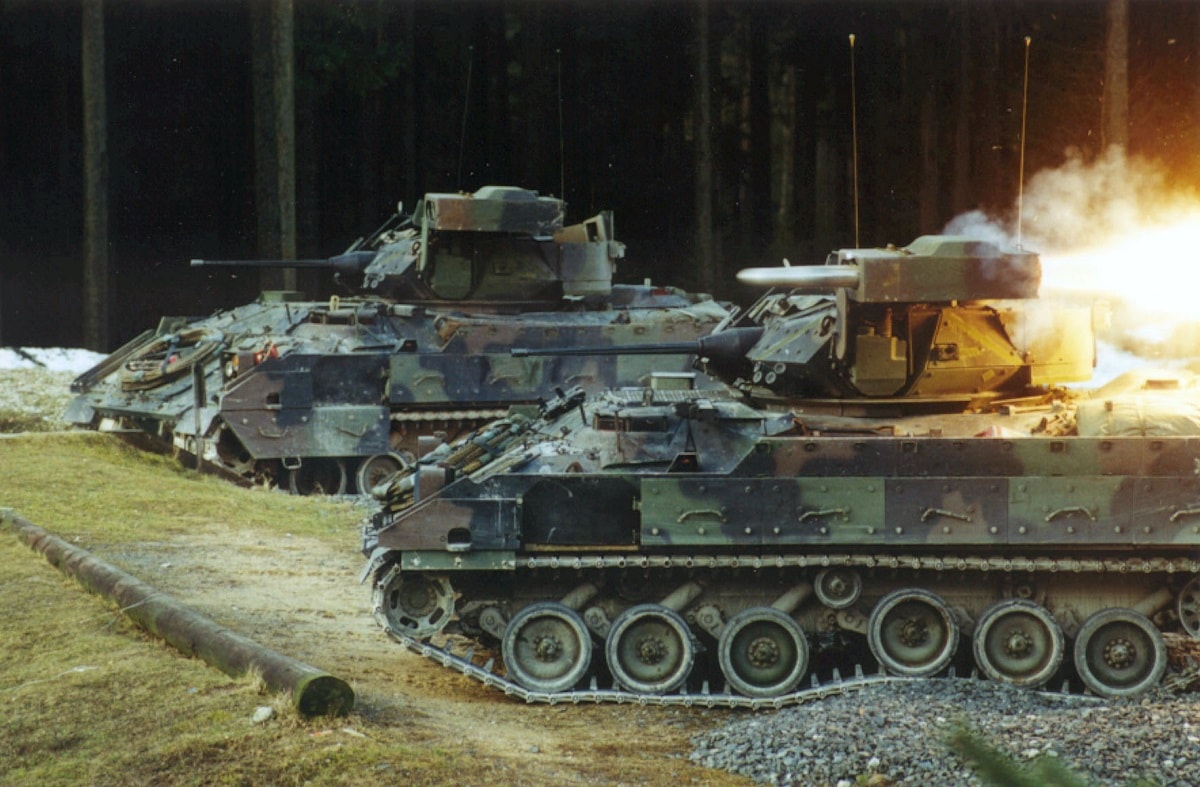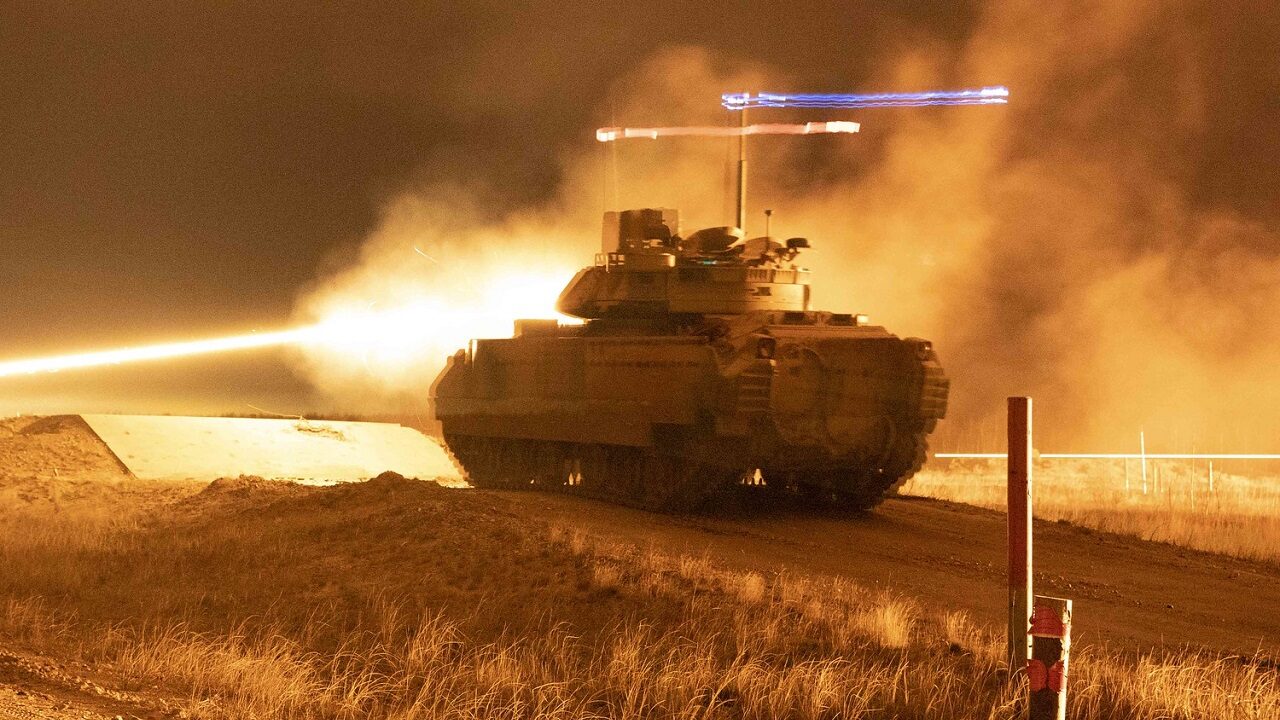Key Points and Summary: The M2 Bradley Infantry Fighting Vehicle has been a key asset in the U.S. Army since 1981, proving its worth in conflicts from the Gulf War to Ukraine.
-Designed to keep pace with the M1 Abrams, the Bradley’s firepower, speed, and adaptability have made it a battlefield staple.
–The Big Question: However, as warfare evolves with new threats like drones and advanced anti-tank weapons, the Bradley is beginning to show its age. How long can it keep fighting?
-Efforts to replace it have failed, leaving the XM-30 as its only potential successor.
Despite these challenges, the Bradley remains a critical tool in modern mechanized warfare—for now.
Is the M2 Bradley Still Relevant in Modern Warfare?
The M2 Bradley Infantry Fighting Vehicle (IFV) is a cornerstone of the U.S. Army’s armored forces, designed to transport infantry while providing substantial firepower and protection. Named after General Omar Bradley, this vehicle has a rich history that spans several decades, reflecting the evolution of military needs and technological advancements.
Origins and Development
The concept for the M2 Bradley emerged during the Cold War, a period marked by intense military competition between the United States and the Soviet Union. In the 1960s, the U.S. Army recognized the need for a new type of armored vehicle that could keep pace with the M1 Abrams main battle tank and provide better protection and firepower than the existing M113 armored personnel carriers.
The development of the Bradley began in earnest in the early 1970s. The U.S. Army sought a vehicle that could serve both as an infantry fighting vehicle and a scout vehicle. The initial design underwent several iterations and testing phases.
By 1976, the design had evolved to include a two-man turret and anti-tank missile capabilities, which were critical for countering the Soviet BMP-1.
The M2 Bradley Enters Service
The M2 Bradley officially entered service in 1981, with fielding beginning in 1983. Manufactured by United Defense (now BAE Systems Land & Armaments), the Bradley was designed to be highly maneuverable and fast enough to keep up with the M1 Abrams.
It featured spaced laminate armor for protection against small arms fire and artillery fragments, and it was equipped with a 25mm M242 Bushmaster chain gun, TOW anti-tank missile launchers, and a 7.62mm coaxial machine gun.
Remarkable Track Record
The Bradley saw its first major combat during the Gulf War in 1991. It proved to be highly effective, reportedly destroying more Iraqi armored vehicles than the M1 Abrams.
The Bradley’s TOW missile system was particularly successful in engaging and destroying enemy tanks. Its performance in the Gulf War solidified its reputation as a formidable infantry fighting vehicle.
In the years following the Gulf War, the Bradley continued to be a key asset in U.S. military operations. It was deployed in the Iraq War and the War in Afghanistan, where it provided essential support to infantry units and demonstrated its versatility in various combat scenarios.
Upgrades and Modernization
Over the years, the M2 Bradley has undergone numerous upgrades to enhance its capabilities and extend its service life. The M2A2 and M2A3 variants introduced improvements in armor protection, firepower, and electronics.
These upgrades included enhanced armor to protect against improvised explosive devices (IEDs), improved targeting systems, and better communication equipment.
The Bradley’s adaptability has allowed it to remain relevant in modern warfare. Despite several attempts to replace it with newer vehicles, such as the Future Combat Systems (FCS) program and the Ground Combat Vehicle (GCV) program, the Bradley continues to be a mainstay of the U.S. Army’s armored forces.
Has the M2 Bradley Reached its Limits?
Despite its reliable service over the years, every vehicle becomes obsolete eventually. The Bradley has been in service for over 40 years at this point, and some critics feel that the IFV is now starting to show its age.

Engineers with the 116th Brigade Engineer Battalion conduct M2A3 Bradley fighting vehicle gunnery qualification on March 27, 2018, Orchard Combat Training Center, south of Boise, Idaho. Combat engineers with the 116th BEB trained through gunnery table XII, evaluating their ability to execute collective platoon-level tasks in a tactical live-fire environment; including integrating dismounted soldiers with their assigned BFV. (U.S. Army National Guard photo by 1LT Robert Barney)
Moreover, lessons in Ukraine have demonstrated that warfare has evolved in ways that the Bradley simply wasn’t designed for. While it has compared relatively well to other armored vehicles, its light armor and lack of defenses against drones have presented many challenges for its Ukrainian operators.
Legacy and Future
Replacing the Bradley has proven to be more challenging than anticipated. With two projects having failed already, its service life has been indefinitely expanded. At this point, only the XM-30 project has any chance of actually replacing the Bradley.
All in all, the Bradley has proven itself to be a remarkable IFV, serving as the backbone of the U.S. Army’s mechanized infantry units. Resilient and reliable, it has played a crucial role in the U.S. Army’s operations for over four decades.

M2 Bradley Infantry Fighting Vehicle.
Even despite its age, it performs well on the battlefield even today.
About the Author Isaac Seitz
Isaac Seitz, a 19FortyFive Defense Columnist, graduated from Patrick Henry College’s Strategic Intelligence and National Security program. He has also studied Russian at Middlebury Language Schools and has worked as an intelligence Analyst in the private sector.

